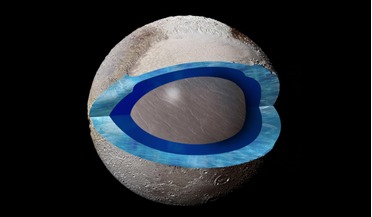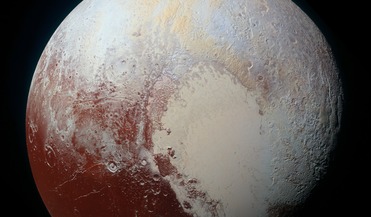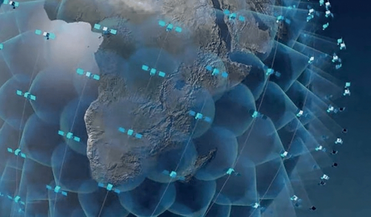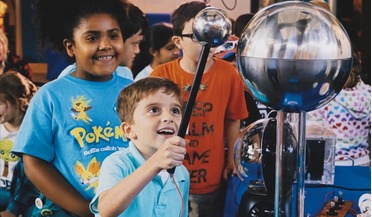ROOM: The Space Journal is one of the major magazines on space exploration, technology and industry. At ROOM, we share a common objective – promotion of peaceful space exploration for the benefit of humankind, all while bringing you incisive articles on an assortment,a range of interesting topics. Our authors include scientists and industry leaders from all over the world, which lets us bring you the most up-to-date and comprehensive information about spacemen 3 sputnik.
 18 November 2016
Pluto's heart is an ocean of slushy ice
18 November 2016
Pluto's heart is an ocean of slushy ice
... links with the evolution of key features such as the vast, low-lying basin known as Sputnik Planitia (formerly Sputnik Planum) on the heart’s western lobe. Tombaugh Regio, which is Pluto's brightest region, has...is seen in images from New Horizons which appear to show nitrogen glaciers flowing out of mountainous terrain around Sputnik Planitia. "Pluto is hard to fathom on so many different levels," says New Horizons co-investigator Richard Binzel,...
 April 2019
Cleaning up space
April 2019
Cleaning up space
More than 60 years after the first Earth orbiting satellite, Sputnik, orbital debris is recognised as a rapidly escalating problem but moves to address the issue remain in relative infancy. Five ... protect and support the sustainability of our orbital assets for future generations. The first artificial satellite, Sputnik-1, was launched in 1957, setting humankind on a course that would lead to a deep reliance on satellite data and technology...
 25 May 2018
New research suggests Pluto could be one giant comet
25 May 2018
New research suggests Pluto could be one giant comet
... been analysing the nitrogen content in the western lobe of Pluto’s “heart” – the near-equatorial region called Sputnik Planitia – to deduce how Pluto was formed. Solid molecular nitrogen (N2) appears to be the most abundant ice on the... ice is able to deform and flow like a very, very slow moving river. This keeps areas such as Sputnik Planitia looking smooth and youthful, but where did all of this nitrogen come from? The duo...
 20 May 2019
A thin layer of ice-trapped gas stops Pluto's oceans from freezing
20 May 2019
A thin layer of ice-trapped gas stops Pluto's oceans from freezing
... the base of Pluto’s ice shell may be enough to insulate the ocean beneath and stop it from freezing. Sputnik Planitia, the half of Pluto’s heart that possible contains a substantial body of water underneath it, is a topographically.... What’s more the gas in the hydrates is most likely methane, and not nitrogen, which is what Sputnik Planitia is thought to be composed of. These molecules once released, then escape to help fill up Pluto’s atmosphere...
 May 2017
Future space applications and their regulatory needs
May 2017
Future space applications and their regulatory needs
... number of satellite constellations in coming years will need focused and specific global traffic magaement rules. Once Sputnik was launched, for several years, objects launched into orbit were termed artificial satellites, but today...
 March 2016
Space Mining – the Reality of Tomorrow?
March 2016
Space Mining – the Reality of Tomorrow?
Today, many would be startled to learn, there are four United States-based companies whose business plans involve ‘space mining’ for profit. These companies include Planetary Resources Inc, Deep Space Industries, Moon Express, and Shackleton Energy Corporation. There is a great abundance of wealth of natural resources on our six sextillion ton planet. But we humans, now numbering some 7.5 billion and likely to grow as large as 12 billion by 2100...
 November 2016
Microgravity and space research: Bringing the commercial market into focus
November 2016
Microgravity and space research: Bringing the commercial market into focus
.... As the capacities increased, the USSR and the USA became capable of sending the first satellites such as Sputnik into space in 1957. The effects of low, or zero gravity, were nevertheless not studied much before the...
 May 2019
Unlocking the full potential of Earth observation
May 2019
Unlocking the full potential of Earth observation
... this data back to Earth is a huge challenge. Radio frequency (RF) technology has hardly changed since the days of Sputnik and no matter how many terabytes of data sensors can collect, RF limits the flow of data to the ground...
 July 2020
Trailblazing STEM education
July 2020
Trailblazing STEM education
... of that moving, beeping beacon. The sky was crystal clear, the Milky Way unpolluted by city lights. Sputnik would kick off a decade-long race to the Moon. Ten years; why so long? That was a lifetime...